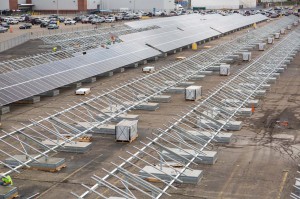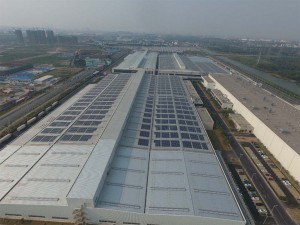
General Motors unveiled its plans to have 100% of its power supplied by renewable resources by 2050.
Typically covering millions of square feet, employing thousands and rolling out hundreds of thousands of cars each year, major auto assembly plants normally aren’t very environmentally friendly. But under increasing scrutiny from regulators and the public alike, carmakers have been stepping up sustainable manufacturing efforts.
General Motors, for example, has largely eliminated waste heading for landfills from many plants. And the Detroit maker says it is committing to using 100% renewable energy at all of its global operations. Just not quite yet. The target won’t be reached until 2050, it says.
“Establishing a 100% renewable energy goal helps us better serve society by reducing environmental impact,” says GM Chairman and CEO Mary Barra. “This pursuit of renewable energy benefits our customers and communities through cleaner air while strengthening our business through lower and more stable energy costs.”
GM has already taken a number of small steps in the switch to renewable energy. At the Detroit-Hamtramck Assembly Plant, where it produces a mix of models including the Chevrolet Volt, for example, a large solar array provides electric power used, among other things, to charge up those plug-in hybrids.
(New film reveals reality of auto bailout. For more, Click Here.)

GM's already begun efforts to use renewable energy sources, such as this 800kW solar array at its Warren (Michigan) transmission plant.
By the end of this year, GM predicts that 3.8% of its electricity will come from solar and other renewable resources. By 2020, it expects to be using 125 megawatts of renewable energy. To put that into perspective, that’s about a quarter of the output of a small nuclear plant, and 20 times more than a single, larger wind turbine. Measured another way, that would be enough to run almost 12,000 U.S. homes.
GM is joining RE100, a collaborative effort of 69 global companies pledging to switch entirely to renewable energy. The list includes Google, HP, IKEA and one other automaker, BMW.
“GM has already saved millions of dollars by using renewable energy, and like any smart business that recognizes an investment opportunity, they want to seize it fully,” said Amy Davidsen, North America executive director at the nonprofit The Climate Group. “We hope that through this leadership, other heavy manufacturing companies will be inspired to make the switch too.”
(Click Here for details about the Chevy Bolt topping the Tesla Model 3.)
A number of other automakers have begun using renewables, with a heavy emphasis on solar, though they have not yet committed to a 100% commitment. That includes Volkswagen, which is setting up millions of square feet of solar arrays at plants including one in Tennessee, and Ford. The latter is putting up a solar “farm” next to its headquarters in suburban Detroit.
Manufacturers are facing increasing pressure to clean up their acts, and not just in the U.S. China, in particular, wants to promote green power as a way to address its endemic smog problems.
Another factor at work is the rapid improvement in solar cell efficiency, even while the cost of the technology has been dropping.
(To see more about GM’s sales growth in China, Click Here.)
Along with solar power, GM plans to expand the use of wind and landfill gas to provide energy to a production, engineering and corporate network that currently includes 350 facilities in 59 countries. It will also use battery storage systems – possibly including recycled Volt batteries – to store excess energy until it is needed. That will help solve one of the problems of renewable power: maintaining a flow of energy when the sun is down or the wind stops blowing.

